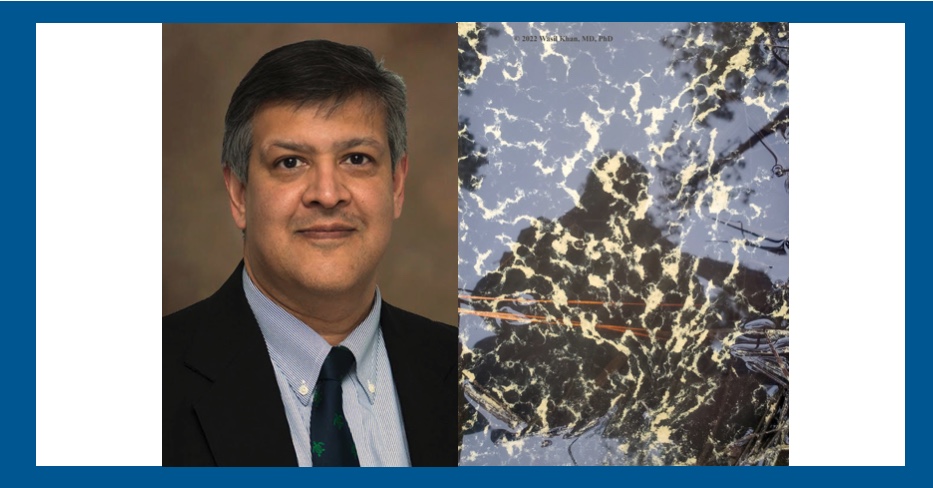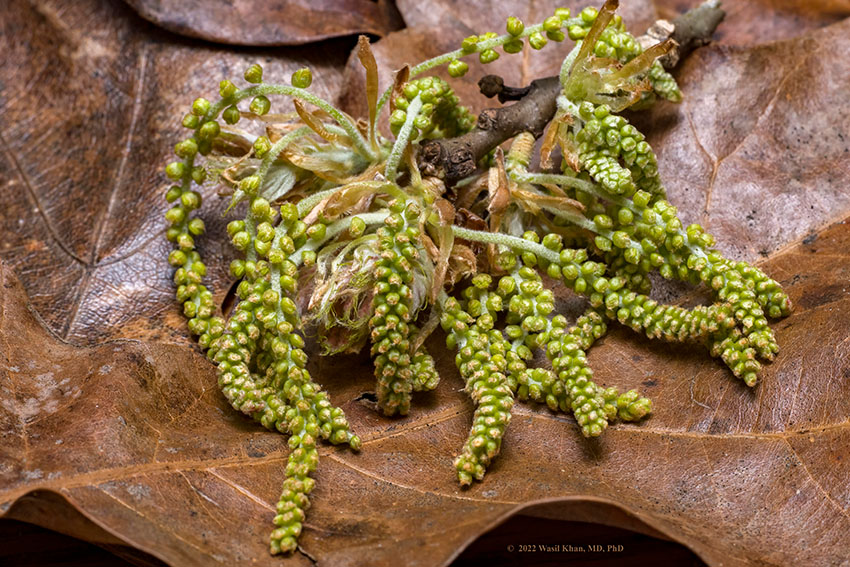Serving the Lowcountry and Coastal Empire of Georgia and South Carolina.
Monday, April 11, 2022

The spring season is a time of renewal. Plants and animals are shaking off winter’s chill, and there is a burst of new growth and activity. People are also spending more time outdoors, enjoying the pleasant weather, sights, and smells that come with the season. Over all of this, comes a fine dusting of yellow pollen, which, for some, makes spring a season of itching, snorting, sneezing, and wheezing.
So, why do some of us suffer during spring pollination while others seem to have no symptoms? The reason lies in our immune system’s response to proteins, called allergens, contained in pollens. These allergens are ignored by the immune systems of people who do not experience symptoms from pollen exposure. The difference that determines whether an allergen is ignored or triggers an allergic response is the presence of immunoglobulin E (IgE). IgE is one of several classes of antibodies produced by our immune system, and it is the class responsible for triggering immediate-type allergic reactions. It does so by binding to an allergen, and triggering release of chemicals that cause allergic symptoms. This binding between IgE and an allergen is very specific, comparable to how a lock fits a specific key. When an IgE-allergen connection occurs, histamine and other inflammatory chemicals are released from mast cells, causing allergic symptoms (Figure 1)*. IgE can also specifically bind allergens from sources other than pollens, such as allergens in foods, animal dander, medications, and stinging insect venoms, thereby making people allergic to these substances as well.
Managing allergies successfully can often be accomplished by decreasing allergen exposure, and using appropriate medications when needed. Sometimes these strategies are not enough to adequately control symptoms. This often occurs when allergen avoidance is not possible, and medications are not sufficiently effective, or if taking medications is associated with intolerable side effects. In these situations, it is often helpful to use allergen immunotherapy, which actually involves introducing relevant allergens into the body, either by injection or by a sublingual melt tablet. This process, over time, ameliorates the allergy. It changes the allergy instead of covering up symptoms from the allergy with medications, and is effective in decreasing symptoms and medication requirements. It is best to enlist the services of an Allergist-Immunologist if the circumstances call for allergen immunotherapy.
Pollen is the dominant allergen class that affects people during the spring. It is produced by flowering plants, including trees, grasses, and weeds. Pollen is the male plants’ contribution to plant reproduction, and it contains allergens that can trigger allergy symptoms when it is inhaled, or when it lands on the eyes, and skin. The effectiveness of a particular plant’s pollen in causing allergy symptoms depends on how it is spread, and structural characteristics of the pollen. For example, the most bothersome pollen types are those that are windborne (anemophilous), and not those that are carried by pollinating insects and other animals (entomophilous / zoophilous). Plants with windborne pollens usually have small, inconspicuous, flowers that are located on structures like catkins seen on oak trees (Figure 2)*. Plants with large, showy flowers, like roses (Figure 3)*, have flamboyant blooms with sweet nectar to attract insects. This is because their pollen is too large to travel on the breeze. These large pollens are not very allergenic. Even among windborne pollens, the smaller ones like those of oaks are more allergenic than larger pine pollens (Figures 4)*. Pine pollens are often blamed for allergy symptoms, but these large, highly visible pollens are not usually the culprit (Figure 5)*. The smaller, less visible pollens which are present at the same time as pine, are the ones responsible.
There are some measures one can take to reduce exposure to airborne pollens including keeping windows closed (vehicle and home), avoiding outdoor activity during the highest pollination hours (morning), and on dry windy days, especially during peak pollination seasons (late winter, spring, and late / summer fall). Rinsing off in the shower after spending time outdoors can reduce pollen-induced symptoms, as can wearing a mask while outdoors during heavy pollen times. Rinsing the nasal and sinus passages with saline can also be helpful in reducing symptoms. While these measures can be helpful, the truth is that it is very difficult to avoid pollen completely during certain times of the year. There is a brief respite from heavy pollination here in Savannah and the surrounding areas in mid-summer, and during the timeframe between the first frost and tree pollination onset in late January.
Properly delving into a discussion of medications used to manage allergies would require more space than is available in this publication, but effective allergy medications are now available without prescription. These include intranasal corticosteroid sprays like fluticasone, budesonide, and triamcinolone; oral antihistamines like cetirizine, loratadine, fexofenadine, and levocetirizine; and ocular antihistamine drops like ketotifen, and olopatadine. These can be tried in accordance with the precautions and directions listed on the product labeling, and can help control nasal and eye allergy symptoms. If the medications are not helpful, it may be due to the symptom cause being something other than an allergy. In the event that symptoms are refractory to medications, it is best to seek the input of a medical professional.
In summary, the spring pollen season can be a challenging time for allergy sufferers. The main allergen group that is responsible for spring allergy symptoms is pollen produced by a rich variety of trees, grasses, and weeds we have here in south coastal Georgia and the South Carolina lowcountry. There are effective allergy management strategies available to allergy sufferers that can help get them through the spring allergy season, including allergen-exposure reduction measures, medications to treat symptoms, and allergen immunotherapy to reduce allergy severity. We at SouthCoast Health Allergy and Asthma are ready to assist allergy sufferers who are having difficulty dealing with allergy symptoms. Please call 912.527.5335 for an appointment if you would like us to help.
*FIGURE CAPTIONS
Figure 1
The mechanism underlying immediate-type allergic reactions. Immunoglobulin E antibodies (IgE) are positioned on the surface of histamine-containing cells like mast cells and basophils. The tail of the IgE antibody is attached to an IgE receptor or the cell surface, and the mouth is exposed to the extracellular environment. The IgE mouth fits an allergen very specifically and, when it binds to its specific allergen, inflammatory chemicals like histamine are released from the cell, causing allergic symptoms like itching, sneezing, swelling, and wheezing.

Figure 2
Catkins from a Red Oak (Quercus rubra) that had fallen to the ground. Catkins house small oak flowers that produce a small, easily windborne (anemophilous), and highly allergenic pollen that is produced beginning around February in our area.
Figure 3
A red rose. Plants with large, showy blooms generally have pollens that are too large to be effectively windborne. The attractive blooms entice insects to visit, thereby picking up and transporting the large pollen grains on their body surface. This strategy of pollen dispersal is called entomophily.
Figure 4
Oak and pine pollen. This slide shows pollens of oak and pine together. The pine pollen is several times larger, and with a more complex structure than oak pollen. This difference is part of the reason that oak pollens are more allergenic. Their small size and structure are thought to make them highly allergenic by allowing them to reach deeper segments of our airways, more effectively inducing allergic sensitization.
Figure 5
Pins pollen covering the water surface beside a dirt road in the forest. The large size of pine pollen makes it highly visible at a time when people with tree pollen allergies are starting to experience allergy symptoms. Therefore, pine is often blamed for causing symptoms. In reality, the smaller, more allergenic, pollen species like those of oak and sweet gum that are the true culprits.
Whether you are looking for a primary care doctor or a pediatrician, or another medical specialist, SouthCoast Health has you covered with its wide range of world-class healthcare services, available throughout the Coastal Empire and Lowcountry. SouthCoast Health has 120 physicians and medical professionals in 16 locations in Savannah, Richmond Hill, Pooler, Rincon, Baxley, Hilton Head, Hinesville, and Statesboro. SouthCoast Health offers comprehensive medical services including: Family Medicine, Internal Medicine, Pediatrics, Allergy and Asthma, Cardiology, Endocrinology, Eye Care, Imaging, Infectious Diseases, Nephrology, Neurology, Physical Therapy, Podiatry, Surgery, Clinical Trial Research Studies, Diabetic Self-Management Training Sessions, Dietetic Counseling, Laboratory Services, Massage Therapy, Optical Shop, Pharmacy, and Urgent Care.